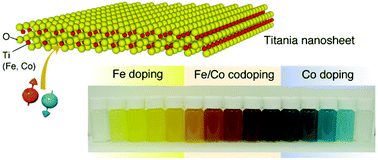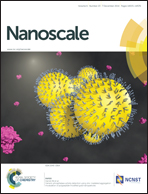Controlled doping of semiconducting titania nanosheets for tailored spinelectronic materials†
Abstract
Ti1−x−yFexCoyO2 nanosheets are synthesized in which the (Fe/Co) content is systematically controlled in the range of 0 ≤ x ≤ 0.4 and 0 ≤ y ≤ 0.2. A key feature of this new preparation is the use of (Li/Fe)-, (Fe/Co)- and (Li/Co)-co-substituted layered titanates as starting materials. In exfoliated nanosheets, the composition can be intentionally modified by controlled Fe/Co substitution into Ti sites during the solid-state synthesis of the starting layered compounds. The composition of the host layers is maintained in the subsequent exfoliation process, which is very helpful in the rational design of nanosheets through the use of controlled doping. Through this controlled doping, we achieve exquisite control of the electronic properties of Ti1-δO2 nanosheets, including the position of impurity bands, the Fermi energy and ferromagnetic properties. From photoelectron spectroscopy and first-principles studies, we have observed that the use of Fe/Co co-doping with higher Fe and Co oxidation states is necessary to bring the highest occupied Fe/Co impurity states to the Fermi level. This band engineering transforms the Ti1−x−yFexCoyO2 nanosheet into a room-temperature half-metallic ferromagnet, thus accomplishing the main requirements of future spinelectronics.


 Please wait while we load your content...
Please wait while we load your content...